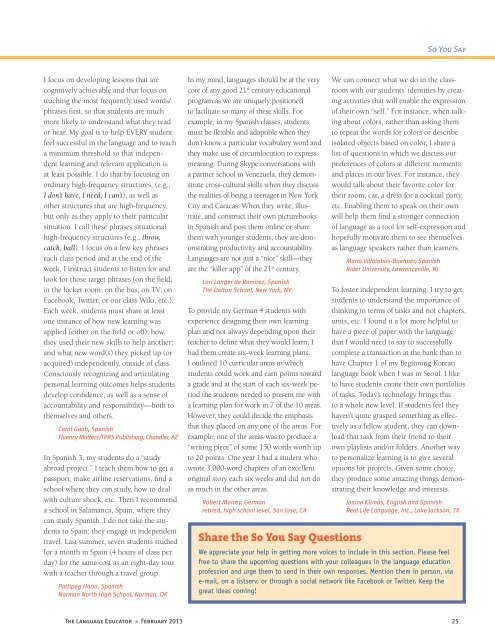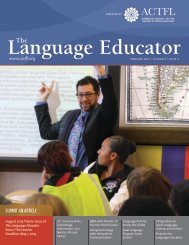Create successful ePaper yourself
Turn your PDF publications into a flip-book with our unique Google optimized e-Paper software.
I focus on developing lessons that are<br />
cognitively achievable and that focus on<br />
teaching the most frequently used words/<br />
phrases first, so that students are much<br />
more likely to understand what they read<br />
or hear. My goal is to help EVERY student<br />
feel successful in the language and to reach<br />
a minimum threshold so that independent<br />
learning and relevant application is<br />
at least possible. I do that by focusing on<br />
ordinary high-frequency structures, (e.g.,<br />
I don’t have, I need, I can’t), as well as<br />
other structures that are high-frequency,<br />
but only as they apply to their particular<br />
situation. I call these phrases situational<br />
high-frequency structures (e.g., throw,<br />
catch, ball). I focus on a few key phrases<br />
each class period and at the end of the<br />
week, I instruct students to listen for and<br />
look for those target phrases (on the field;<br />
in the locker room; on the bus; on TV; on<br />
Facebook, Twitter, or our class Wiki, etc.).<br />
Each week, students must share at least<br />
one instance of how new learning was<br />
applied (either on the field or off); how<br />
they used their new skills to help another;<br />
and what new word(s) they picked up (or<br />
acquired) independently, outside of class.<br />
Consciously recognizing and articulating<br />
personal learning outcomes helps students<br />
develop confidence, as well as a sense of<br />
accountability and responsibility—both to<br />
themselves and others.<br />
Carol Gaab, Spanish<br />
Fluency Matters/TPRS Publishing, Chandler, AZ<br />
In Spanish 3, my students do a “study<br />
abroad project.” I teach them how to get a<br />
passport, make airline reservations, find a<br />
school where they can study, how to deal<br />
with culture shock, etc. Then I recommend<br />
a school in Salamanca, Spain, where they<br />
can study Spanish. I do not take the students<br />
to Spain; they engage in independent<br />
travel. Last summer, seven students studied<br />
for a month in Spain (4 hours of class per<br />
day) for the same cost as an eight-day tour<br />
with a teacher through a travel group.<br />
Pattipeg Harjo, Spanish<br />
Norman North High School, Norman, OK<br />
In my mind, languages should be at the very<br />
core of any good 21 st century educational<br />
program as we are uniquely positioned<br />
to facili tate so many of these skills. For<br />
example, in my Spanish classes, students<br />
must be flexible and adaptible when they<br />
don’t know a particular vocabulary word and<br />
they make use of circumlocution to express<br />
meaning. During Skype conversations with<br />
a partner school in Venezuela, they demonstrate<br />
cross-cultural skills when they discuss<br />
the realities of being a teenager in New York<br />
City and Caracas. When they write, illustrate,<br />
and construct their own picturebooks<br />
in Spanish and post them online or share<br />
them with younger students, they are demonstrating<br />
productivity and accountability.<br />
Languages are not just a “nice” skill—they<br />
are the “killer app” of the 21 st century.<br />
Lori Langer de Ramirez, Spanish<br />
The Dalton School, New York, NY<br />
To provide my German 4 students with<br />
experience designing their own learning<br />
plan and not always depending upon their<br />
teacher to define what they would learn, I<br />
had them create six-week learning plans.<br />
I outlined 10 curricular areas in which<br />
students could work and earn points toward<br />
a grade and at the start of each six-week period<br />
the students needed to present me with<br />
a learning plan for work in 7 of the 10 areas.<br />
However, they could decide the emphasis<br />
that they placed on any one of the areas. For<br />
example, one of the areas was to produce a<br />
“writing piece” of some 150 words worth up<br />
to 20 points. One year I had a student who<br />
wrote 3,000-word chapters of an excellent<br />
original story each six weeks and did not do<br />
as much in the other areas.<br />
Robert Morrey, German<br />
retired, high school level, San Jose, CA<br />
Share the So You Say Questions<br />
We can connect what we do in the classroom<br />
with our students’ identities by creating<br />
activities that will enable the expression<br />
of their own “self.” For instance, when talking<br />
about colors, rather than asking them<br />
to repeat the words for colors or describe<br />
isolated objects based on color, I share a<br />
list of questions in which we discuss our<br />
preferences of colors at different moments<br />
and places in our lives. For instance, they<br />
would talk about their favorite color for<br />
their room, car, a dress for a cocktail party,<br />
etc. Enabling them to speak on their own<br />
will help them find a stronger connection<br />
of language as a tool for self-expression and<br />
hopefully motivate them to see themselves<br />
as language speakers rather than learners.<br />
Maria Villalobos-Buehner, Spanish<br />
Rider University, Lawrenceville, NJ<br />
So You Say<br />
To foster independent learning, I try to get<br />
students to understand the importance of<br />
thinking in terms of tasks and not chapters,<br />
units, etc. I found it a lot more helpful to<br />
have a piece of paper with the language<br />
that I would need to say to successfully<br />
complete a transaction at the bank than to<br />
have Chapter 1 of my Beginning Korean<br />
language book when I was in Seoul. I like<br />
to have students create their own portfolios<br />
of tasks. Today’s technology brings this<br />
to a whole new level. If students feel they<br />
haven’t quite grasped something as effectively<br />
as a fellow student, they can download<br />
that task from their friend to their<br />
own playlists and/or folders. Another way<br />
to personalize learning is to give several<br />
options for projects. Given some choice,<br />
they produce some amazing things demonstrating<br />
their knowledge and interests.<br />
Janina Klimas, English and Spanish<br />
Real Life Language, Inc., Lake Jackson, TX<br />
We appreciate your help in getting more voices to include in this section. Please feel<br />
free to share the upcoming questions with your colleagues in the language education<br />
profession and urge them to send in their own responses. Mention them in person, via<br />
e-mail, on a listserv, or through a social network like Facebook or Twitter. Keep the<br />
great ideas coming!<br />
The Language Educator n February 2013 25



